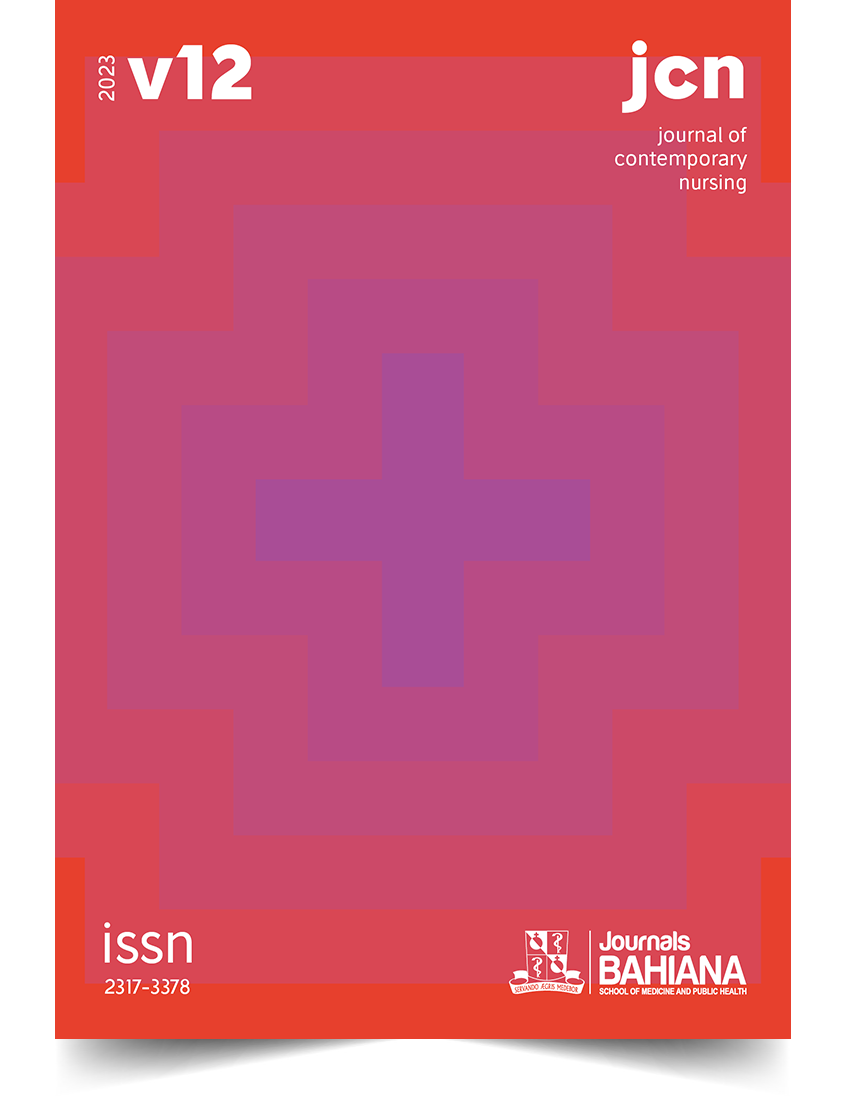Perception of the professionals of radiologic techniques facing the humanization of care in radiotherapy
DOI:
https://doi.org/10.17267/2317-3378rec.2023.e5053Keywords:
Humanization of Assistance, Radiotherapy, Medical Oncology, Health PersonnelAbstract
OBJECTIVE: To describe the perception of professionals in radiological techniques regarding the humanization of care in a reference center for radiotherapy treatment. METHOD: This is a descriptive study with a qualitative approach that was developed from field research in a reference center in oncology in the South of Brazil. Seven professionals in radiological techniques participated in the study. The data collection instrument was developed with two open questions based on the National Humanization Policy. The data were analyzed based on the assumptions of Bardin's Thematic Content Analysis. RESULTS: Radiology professionals expressed empathy, interest in the health condition of others, and the bond between user and professional as factors that contribute to humanized care. Among the factors that hinder humanized care, the lack of a professional, a well-established routine, and the reduced time for treatment was listed. CONCLUSION: In radiotherapy care, radiology professionals must be attentive to the emotional and physical signs of the user. From this, a humanized and positive relationship of trust and recognition is built.
Downloads
References
(1) Ministério da Saúde (Brasil), Secretaria de Atenção à Saúde, Núcleo Técnico da Política Nacional de Humanização. HumanizaSUS: documento base para gestores e trabalhadores do SUS [Internet]. 3a. ed. Brasília: Ministério da Saúde; 2006. Available from: https://bvsms.saude.gov.br/bvs/publicacoes/documento_base.pdf
(2) Silva IN, Pereira VA, Araújo LCN. Implantação da Política Nacional de Humanização (PNH): conquistas e desafios para a assistência em saúde. Gepnews [Internet]. 2018;1(1):2-7. Available from: https://www.seer.ufal.br/index.php/gepnews/article/view/4674
(3) Chandra RA, Keane FK, Voncken FEM, Thomas Jr CR. Contemporary radiotherapy: present and future. Lancet. 2021;398(10295):171-84. https://doi.org/10.1016/S0140-6736(21)00233-6
(4) Carlson LE, Zelinski EL, Toivonen KI, Sundstrom L, Jobin CT, Damaskos P, et al. Prevalence of psychosocial distress in cancer patients across 55 North American cancer centers. J Psychosoc Oncol. 2019;37(1):5-21. https://doi.org/10.1080/07347332.2018.1521490
(5) Brito NTG, Carvalho R. Humanization according to cancer patients with extended hospitalization periods. Einstein. 2010;8(2):221-27. http://dx.doi.org/10.1590/s1679-45082010ao1369
(6) Santos MR, Silva L, Misko MD, Poles K, Bousso RS. Unveiling humanized care: nurses’ perceptions in pediatric oncology. Texto Contexto Enfermagem. 2013;22(3):646-53. http://dx.doi.org/10.1590/s0104-07072013000300010
(7) Pott FS, Stahlhoefer T, Felix JVC, Meier MJ. Comfort and communication measures in nursing caring actions for critically ill patients. Rev. Bras. Enferm. 2013;66(2):174-79. http://dx.doi.org/10.1590/s0034-71672013000200004
(8) Resolução n° 02, de 04 de maio de 2012. Institui e normatiza atribuições, competências e funções do Profissional Tecnólogo em Radiologia [Internet]. Conselho Nacional de Técnicos em Radiologia. Available from: http://conter.gov.br/uploads/legislativo/n._02_2012.pdf
(9) Trombaco AL, Negrisoli L. Função do tecnólogo em radiologia no setor de radioterapia [Internet]. 7ª Jornada Científica e Tecnológica da Fatec de Botucatu; 2018; Botucatu, SP. Available from: http://www.jornacitec.fatecbt.edu.br/index.php/VIIJTC/VIIJTC/paper/viewFile/1687/2008
(10) Silva MP, Taumaturgo ICB. The role of the professional in radiological techniques and the importance of humanized care in the radiotherapy sector Braz. J Dev. 2021;7(7):73303-11. https://doi.org/10.34117/bjdv7n7-485
(11) Bardin L. Análise de Conteúdo. São Paulo: Edições 70; 2016.
(12) Lopes ACA. A radioterapia nos cuidados paliativos: perspetiva do radioterapeuta [masters dissertation] [Internet]. Porto: Faculdade de Medicina da Universidade do Porto Porto; 2016. Available from: https://hdl.handle.net/10216/89379
(13) Costa CA, Lunardi Filho WD, Soares NV. Humanized assistance with an oncology patient: reflections with the health team. Rev. Bras. Enferm. 2003;56(3):310-14. http://dx.doi.org/10.1590/s0034-71672003000300019
(14) Anacleto G, Cecchetto FH, Riegel F. Humanized nursing care to cancer patients: an integrative review. Rev. Enferm. Contemp. 2020;9(2):246-54. https://doi.org/10.17267/2317-3378rec.v9i2.2737
(15) Campos CFC, Fígaro R. The medical-patient relationship under the light of communication and work. Rev Bras Med Fam Comunidade. 2021;16(43):2352. https://doi.org/10.5712/rbmfc16(43)2352
(16) Bragé ÉG, Macedo E, Rabin EG. Group for women with breast cancer in radiotherapy. Rev enferm UFPE on line. 2021;15(2):e244830. http://dx.doi.org/10.5205/1981-8963.2021.244830
(17) Lievens Y, Defourny N, Coffey M, Borras JM, Dunscombe P, Slotman B, et al. Radiotherapy staffing in the European countries: final results from the ESTRO-HERO survey. Radiother Oncol. 2014;112(2):178-86. http://dx.doi.org/10.1016/j.radonc.2014.08.034
(18) Cézar SV, Souza JSM. Nunsing’s view on humanized care in the urgent and emergency sector. Semin., Ciênc. Biol. Saúde (Online). 2021;42(1):81-90. https://doi.org/10.5433/1679-0367.2021v42n1p81
(19) Resolução CNEN n° 176, de 27 de novembro de 2014. Requisitos de Segurança e Proteção Radiológica para Serviços de Radioterapia. Ministério da Ciência, Tecnologia e Inovação [Internet]. Comissão Nacional de Energia Nuclear. Available from: http://appasp.cnen.gov.br/seguranca/normas/pdf/Nrm610.pdf
(20) Zubizarreta EH, Fidarova E, Healy B, Rosenblatt E. Need for radiotherapy in low and middle income countries – the silent crisis continues. Clin Oncol (R Coll Radiol). 2015;27(2):107-14. http://dx.doi.org/10.1016/j.clon.2014.10.006
(21) Gurske BH, Silva E. Evidenciando as políticas de gestão de qualidade e segurança em pacientes que realizam tratamentos de radioterapia. Cadernos Zygmunt Bauman [Internet]. 2019;9(21):122-29. Available from: http://periodicoseletronicos.ufma.br/index.php/bauman/article/view/11273
(22) Almeida LS. Práticas de gestão de processos e de cultura de segurança em serviços de radioterapia e impactos na qualidade do cuidado e na segurança do paciente [masters dissertation] [Internet]. São Carlos: Universidade Federal de São Carlos; 2020. Available from: https://repositorio.ufscar.br/handle/ufscar/13553
Downloads
Published
Issue
Section
License
Copyright (c) 2023 Maria Luiza da Rosa de Avila, Charlene da Silva, Juliana dos Santos Müller, Layla de Souza Coelho

This work is licensed under a Creative Commons Attribution 4.0 International License.
This work is licensed under a Creative Commons Attribution 4.0 International License.



